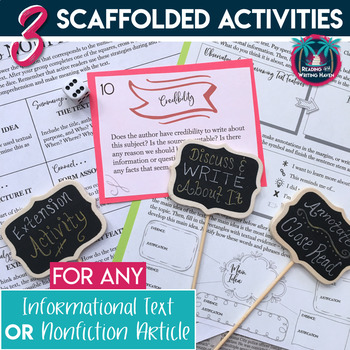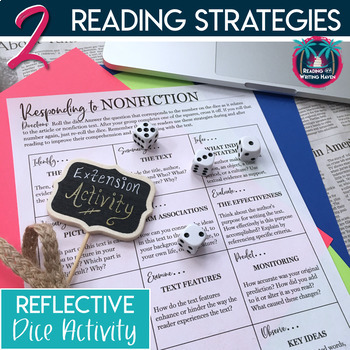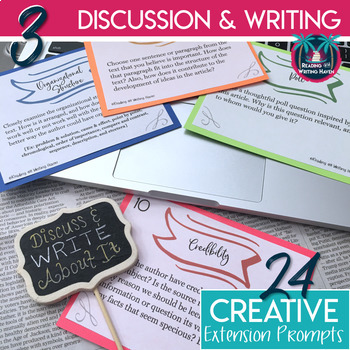Informational Text: 3 Scaffolded Activities for Any Nonfiction Article
- PDF
What educators are saying
Also included in
- Do you want your students to think critically, thoughtfully, and reflectively about what they are reading? Are you in need of a way to scaffold literary analysis and reading comprehension? This huge reading graphic organizers bundle contains graphic organizers and activities that you can use with anPrice $32.00Original Price $39.48Save $7.48
Description
Looking for best instructional practices to use with informational or nonfiction texts? Meeting rigorous RI standards can be challenging when students are frustrated or disengaged. Secondary teachers can scaffold the comprehension process to help students feel confident and achieve success.
This teaching resource works with any nonfiction or informational text you select for your students. It is appropriate for periodicals, exemplar texts, speeches, and informational chapter book excerpts. Use the exercises as test prep, as part of your reading unit, as a complementary activity with a nonfiction paired text, as station activities, and more.
This nonfiction article resource contains the following activities for any nonfiction article informational text:
1. A close reading and annotation exercise. It features two options. One asks students to annotate in the margins of the text or with sticky notes. The other asks students to respond by writing their answers on the page provided. Choose the option that works best for you, depending on whether you have access to printed texts that students can mark on. This initial activity asks students to read the text more than one time and is intended to help them with basic comprehension.
2. A dice activity. This exercise can be completed individually, with pairs, or with small groups. Students will need one dice to play. The questions focus on reading comprehension and analysis at varying depth of knowledge levels. It encourages students to comb through the text again, reflecting on what they understand and enhancing their original thoughts.
3. 24 task cards that function as discussion or writing prompts. An answer sheet is provided, but students can also choose to express their thoughts or type them. These task cards focus on more analytical, higher-order thinking about the text. Some questions require creativity. All require critical thinking. Teachers may choose a handful to use as a carousel or collaborative activity, or you may decide to use all of them.
This teaching tool contains three, scaffolded activities for any nonfiction article, not the informational texts and nonfiction articles themselves. Newsela, Common Lit, the New York Times Upfront, or the texts suggested as Common Core exemplars are a great place to start.
Due to the complexity of the questions, these activities are recommended for high school or advanced junior high students. Each exercise takes approximately one 45-minute class period to complete.
NOTE: This resource is also included in a larger bundle, Reading Literature and Informational Texts Graphic Organizer Activity Bundle.
If you find this product useful, make sure to check out these similar reading comprehension tools:
Summarizing Nonfiction Texts Mini-Unit
Reading Comprehension Task Cards
Body Farms Nonfiction Podcast Listening Guide
And more here!
Stay in touch:
~~~~~~~~~~~~~~~~~~~~~~~~~~~~~~~~~~~~~~~~~~~~~~~~~~~~~~~~~~
A Couple Tips:
* Be sure to click the "follow" button that is located next to my picture so that you can hear about sales and new products!
* By providing feedback on your purchased products, you can earn points, which ultimately translate into cash toward future purchases...bonus! Plus, I'd love to hear from you.
©Reading and Writing Haven
All rights reserved by author.
Duplication limited to single classroom use only.
Electronic distribution limited to single classroom use only.






